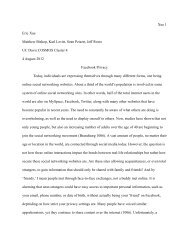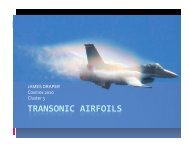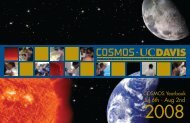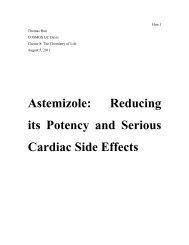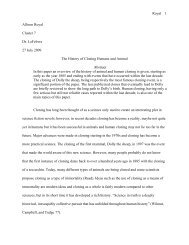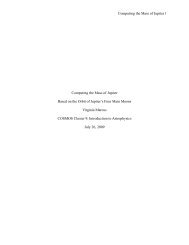High Speed Aerodynamics - COSMOS
High Speed Aerodynamics - COSMOS
High Speed Aerodynamics - COSMOS
You also want an ePaper? Increase the reach of your titles
YUMPU automatically turns print PDFs into web optimized ePapers that Google loves.
<strong>High</strong> <strong>Speed</strong><strong>Aerodynamics</strong>Reference:http://faculty.rmwc.edu/tmichalik/physmov.htmJennifer McBethArul Suresh<strong>COSMOS</strong>, Cluster 3August 2, 2007
Brief History of <strong>High</strong> <strong>Speed</strong> Flight• World War II spurred interest in high speedaircraft• In 1940, the Bell aircraft company wascommissioned to build a research aircraft(X1) to try to reach & overcome the speed ofsound• US did not use wind tunnels, but Germanybuilt the first supersonic tunnel and used it forresearch• But on October 14, 1947, it was the X1 thatbecame the first aircraft to fly faster then thespeed of sound, flown by Chuck Yeager
Mach NumberThe ratio of the aircraft’s speed to the speedof sound• When M
Shock waves• Have large amplitude,at supersonicvelocity, characterizedby an amplitudedependentwavevelocity• Oblique shock wave:– Inclined at an obliqueangle to the direction ofairflow (as opposed toa normal shock wavewhich is perpendicularto the direction of flow)Reference: www.wikipedia.org/wiki/Shock_wave
Expansion fans• A region where thepressure isdecreasing and theairflow isaccelerating• Occurs when asupersonic airflowreaches an outsidecorner and theairflow expandsReference: www.wikipedia.org/wiki/Expansion_fan
Forces on an Airplane• There are four major forcesacting on an airplane:–Weight– Lift– Drag– ThrustReference:
What’s the difference at highspeed?• At high speed, there is a new form of drag• The mechanism of lift also changes.
Transonic Flight• Definition: Flight in which part of the flowover the airplane is supersonic;characterized by a significant increase indrag and a decrease in lift• Normal shock• Possible boundary layer separationReference: http://www.stanford.edu/~jrdx/shock.html
Boundary Layer Separation•The vortex from the VortexGenerator re-energizes theboundary layer, preventingflow separation•Flow separation wouldcause a loss of lift and anincrease in drag (ParasiteDrag).Reference:http://selair.selkirk.bc.ca/aerodynamics1/<strong>High</strong>-
These are the vortex generators on a Boeing 777wing.Reference: http://web.lemoyne.edu/~hevern/2001trip/Aug4-5.html
Supersonic flightFlight in which the speed of the aircraftexceeds that of the speed of sound
• Wave dragSupersonic Drag– Shock waves cause a discontinuity in thecharacteristics of the air--the pressureincreases, and the velocity decreases. Theenergy required to form shock wavescauses drag.– Force is now normal to the wing (instead ofnormal to the flow), causing drag.
Bow shock• If an airfoil with a round LE isused, then that causes anarea of stagnation, where theair pressure is much higherthan the surroundings– This also takes energy, and thepressure pushes back againstthe wing. To solve this, thereare few solutions.Reference: waterocket.explorer.free.fr/images/bullet1.jpg
Supersonic LiftAirfoils: diamond, BI-ellipticalIncrease sweep
Reference:http://selair.selkirk.bc.ca/aerodynamics1/<strong>High</strong>-<strong>Speed</strong>/default.htmAirfoilsLow <strong>Speed</strong> AirfoilIdeal Supersonic AirfoilsBi-convex Airfoil<strong>High</strong> <strong>Speed</strong> AirfoilDouble Wedge Airfoil
At Positive Alpha• The shock wave under the front of the wingstrengthens, and creates an area of higherpressure under the front half of the wing.• The expansion fan on top strengthens, andcreates a low-pressure area over the backhalf of the wing.• Lift is generated.• The center of pressure shifts back to ~50%chord.
SweepReference:http://selair.selkirk.bc.ca/aerodynamics1/<strong>High</strong>-<strong>Speed</strong>/default.htm
• When air passes through an obliqueshock, the component perpendicular tothe shock is slowed to subsonic speeds– Therefore, if the wing is swept more thanthe mach angle, then the air flowingperpendicularly to the wing is subsonic,and so a subsonic airfoil can be used.
Supersonic Propulsion• If a turbojet or turbofan is used atsupersonic speeds, the air entering thejet intake needs to be subsonic, andthere are several ways to accomplishthis.
Reference:http://selair.selkirk.bc.ca/aerodynamics1/<strong>High</strong>-<strong>Speed</strong>/default.htm
Reference:http://selair.selkirk.bc.ca/aerodynamics1/<strong>High</strong>-<strong>Speed</strong>/default.htm
Reference:http://selair.selkirk.bc.ca/aerodynamics1/<strong>High</strong>-
Center Body DiffuserReference:http://selair.selkirk.bc.ca/aerodynamics1/<strong>High</strong>-
Reference:http://selair.selkirk.bc.ca/aerodynamics1/<strong>High</strong>-<strong>Speed</strong>/default.htm
Conclusion• There are dramatic differences betweenlow speed and high speed flight• Transonic flight is flight near Mach 1• Supersonic flight is flight over Mach 1• Compressibility effects must be takeninto account.
Bibliography• http://selair.selkirk.bc.ca/aerodynamics1/<strong>High</strong>-<strong>Speed</strong>/default.htm• waterocket.explorer.free.fr/images/bullet1.jpg• http://history.nasa.gov/SP-4219/4219-060.jpg• http://web.lemoyne.edu/~hevern/2001trip/Aug4-5.html• http://www.stanford.edu/~jrdx/shock.html• http://quest.nasa.gov/aero/background• http://www.grc.nasa.gov/WWW/K-12/airplane/mach.html• http://faculty.rmwc.edu/tmichalik/physmov.htm• http://www.wikipedia.org/wiki/Expansion_fan• http://www.wikipedia.org/wiki/Shock_wave
AcknowledgementsProfessor HafezMike Paskowitz




